I Tried 8 Popular Kimchi Brands & the Best Was Perfectly Tangy and Crunchy
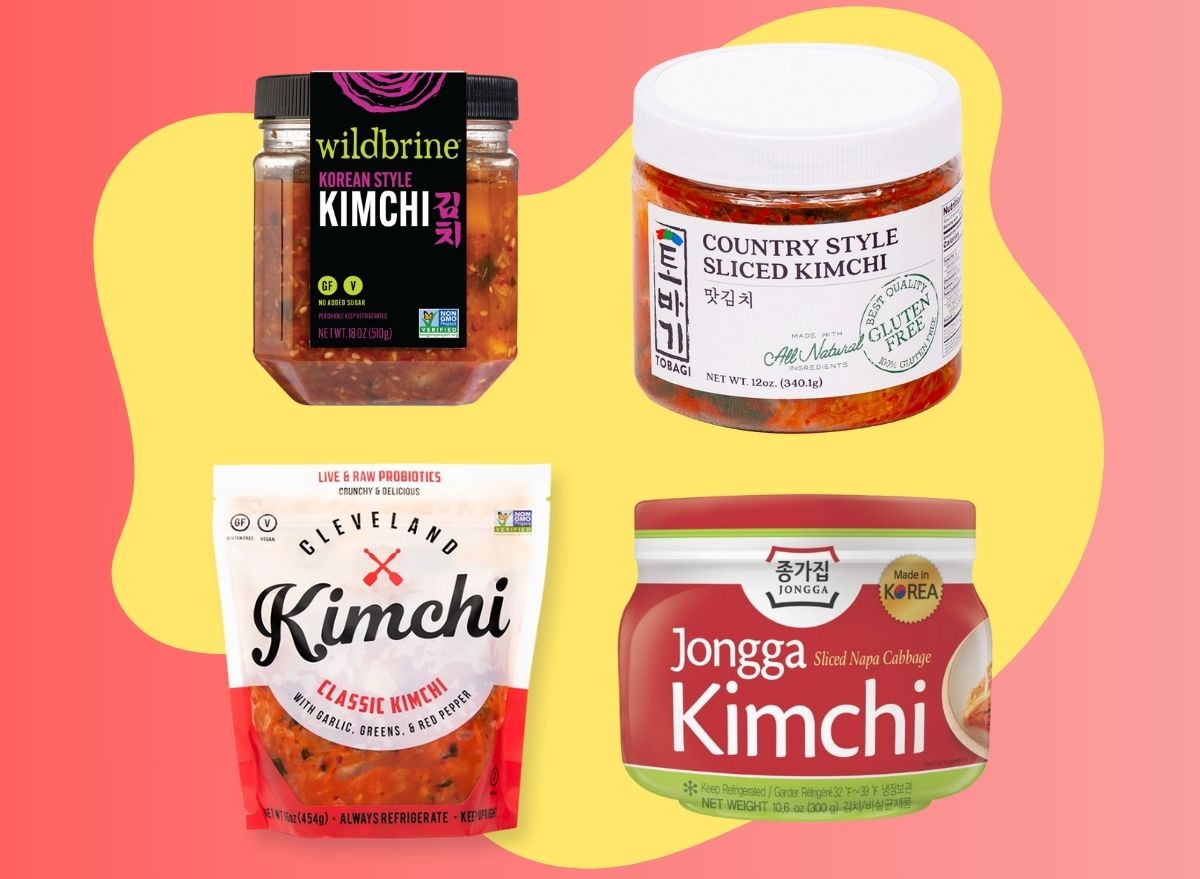
Kimchi is a traditional Korean pickle made from fermenting vegetables. You can turn pretty much any vegetable into kimchi, but the most common version, called baechu kimchi, is made with napa cabbage, often alongside scallions, ginger, garlic, and other flavorings. The fermentation and spices imbue kimchi with a salty, sour, and fiery taste and plenty of gut-friendly probiotics. Kimchi can range from extremely acidic to savory-sweet depending on what seasonings are added.
While recipes vary depending on the region, traditional Korean kimchi typically utilizes gochugaru, red chili flakes, a chili paste called gochujang, and umami-enhancing components like fish sauce or shrimp paste. The longer kimchi is allowed to ferment, the stronger it tastes. In Korea, well-sealed kimchis that are two or three years old are considered delicacies. Store-bought versions typically last eight to twelve months, depending on how they are stored.
Homemade kimchi is always best, but when you don’t have the time or tools to make your own, store-bought will have to do. Fortunately, kimchi has become popular enough here in America to be found in most major supermarkets. I recently tried eight popular store-bought baechu kimchis to see which one reigns supreme. Here’s how each brand fared, ranked in descending order from my least favorite to the best of the whole bunch.
Wildbrine Korean-Style Kimchi

Calories: 10
Fat: 0 g (Saturated Fat: 0 g)
Sodium: 260 mg
Carbs: 1 g (Fiber: 1 g, Sugar: 0 g)
Protein: 0 g
Wildbrine originally started in the sauerkraut business and expanded to a full range of kimchis, organic sauerkrauts, specialty pickled vegetables, salsas, and Srirachas. I tried the gluten-free and completely vegan Korean-style kimchi, which retails for $7.99 at Sprouts.
The look: The jar is not super easy to open because the packaging is taped across the top, and I’m not sure how tight the seal was because it felt wet when I opened the jar. The kimchi itself consists of small, thin cross-cuts of cabbage with aesthetically pleasing green onion and sesame seeds.
The taste: Wildbrine somehow managed to spice but not flavor. The cabbage is limp and thin with no bite to it, and the high level of fermentation produces a palpable fizz when it hits the tongue. There’s a dry spiciness that hits the tip of the tongue without any sweetness to balance it out, so it tastes more like spicy sauerkraut than kimchi.
Mother-In-Law’s Everyday Kimchi
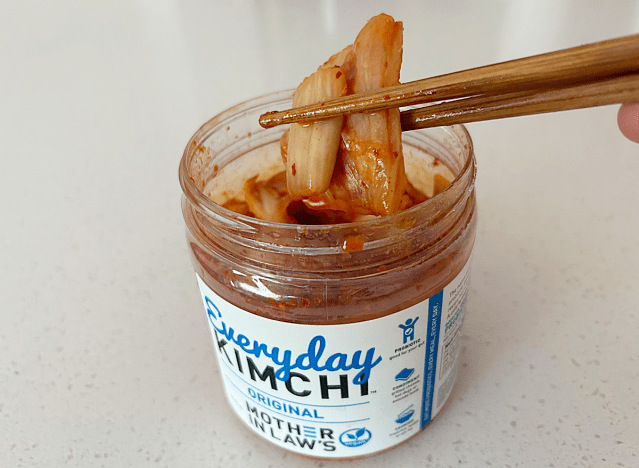
Calories: 10
Fat: 0 g (Saturated Fat: 0 g)
Sodium: 150 mg
Carbs: 2 g (Fiber: 1 g, Sugar: 0 g)
Protein: 1 g
Lifelong foodie and cookbook author Lauryn Chun founded Mother-In-Law’s Kimchi in 2009 as an ode to the tradition of Korean brides learning how to make kimchi from their mother-in-laws. I tried the Everyday Kimchi original, a vegan napa cabbage kimchi based on the brand’s earliest original recipes, retailing for $7.29 at Sprouts.
The look: A clean, digestible design on the jar announcing its uses—probiotic, condiment, cooking—makes it more approachable for unfamiliar Western consumers wandering the grocery aisle. The kimchi itself consists of two-inch-long pieces of napa cabbage with no visible scallions, garlic, or greenery.
The taste: Unfortunately, despite a great origin story, Mother-In-Law’s fell flat on the tongue. Or, I should say, overwhelmingly sour—almost like it was pickled it in pure vinegar. There wasn’t any fizziness you should get from well-fermented kimchi and nothing to balance out the sourness. If your mouth puckers from lemon drops, I would avoid this one.
Madge’s Spicy Kimchi
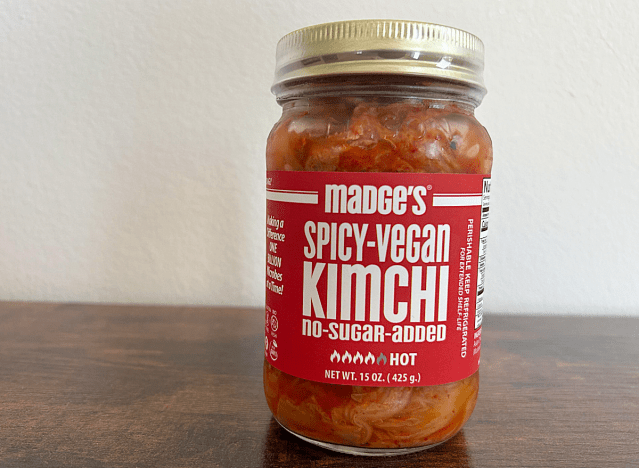
Calories: 8
Fat: 0 g (Saturated Fat: 0 g)
Sodium: 125 mg
Carbs: 2 g (Fiber: 0.5 g, Sugar: 1 g)
Protein: 0.5 g
Texas company Madge’s continues the pickling tradition of the co-founder’s grandmother by churning out fermented foods like kimchi, sauerkraut, bloody mary mix, and spicy pickled vegetables. I tried the vegan, no-sugar-added Madge’s Spicy Kimchi, which retails for $9.49 at my Whole Foods.
The look: Madge’s kimchi opts for a “Southern pickles” kind of jar and label, and the kimchi itself has visible scallions and a slightly smaller chop than the other kimchis.
The taste: Though the label has four out of five flames, warning consumers of the spice level, it’s not as spicy as Wildbrine’s “original Korean” flavor. The spice doesn’t hit your throat as aggressively but rather enhances the flavor. The texture is more toothsome and tastes fresher and not as slimy as some of the other kimchis. Opening the jar, I can smell significantly more garlic right away, compared to the pure vinegar of the first two, and though pungent, there is a pleasant aftertaste. This is probably one of the best vegan kimchis you’ll find in American supermarkets.
Trader Joe’s Kimchi
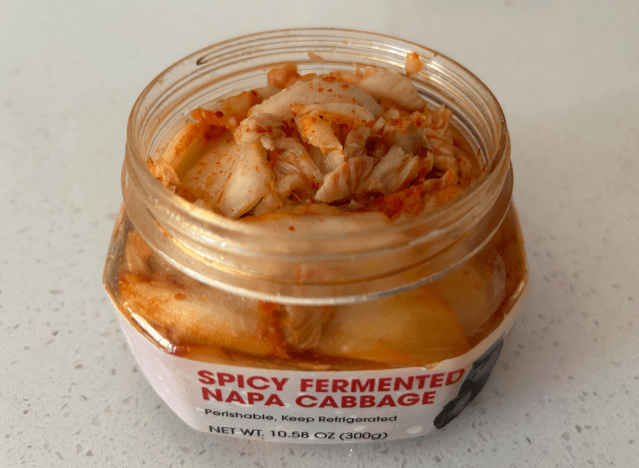
Calories: 10
Fat: 0 g (Saturated Fat: 0 g)
Sodium: 240 mg
Carbs: 5 g (Fiber: 0 g, Sugar: 0 g)
Protein: Less Than 1 g
Trader Joe’s has its own brand of spicy fermented napa cabbage kimchi that is a similar size as the previous ones and retails for only $3.99.
The look: The airtight seal comes from external plastic wrapping, so you hear the jar fizz as you take the plastic wrap off. The kimchi consists of small, unevenly cut pieces of cabbage.
The taste: This is probably the most “neutral” kimchi, as it is less salty as the others with no strong flavors. The texturally sound cabbage is crunchy and thick, producing a pleasant fermented fizz on the tongue. However, there isn’t much garlic or spices so if you like a more traditional, garlicky kimchi it might not hit the spot.
Cleveland Kitchen Classic Kimchi
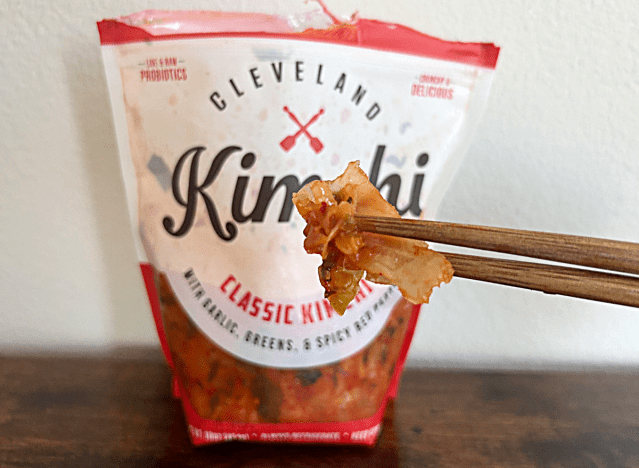
Calories: 10
Fat: 0 g (Saturated Fat: 0 g)
Sodium: 270 mg
Carbs: 3 g (Fiber: 1 g, Sugar: 2 g)
Protein: 0 g
Midwest company Cleveland Kitchen makes fermented kraut, pickles, and kimchi, which are perfect for pairing with grilled meats at the ballpark. I tried the brand’s classic kimchi with garlic, greens, and spicy red pepper, which retails for $6.99 at Sprouts.
The look: I personally dislike kimchi that comes in a bag. Even if the seal is tight, it won’t store for as long and also detracts from the overall experience that comes with opening a jar of kimchi. That bag is an extra reminder you’re buying something made in a factory. The kimchi itself, consisting of tiny pieces of pickled cabbage mixed with peppers and chunks of garlic, looks more like sauerkraut or a Chinese-style pickle. Yet, it’s the perfect chop for topping hot dogs or hamburgers.
The taste: I really enjoyed the sweet and smoky flavors of Cleveland Kitchen Classic Kimchi as well as the chunks of pickled garlic in there. The garlic is stronger than the other American brands, but is well balanced by the smokiness of the peppers, which kept me coming back. As the brand name’s origins suggest, the smoky sweet flavors and fine chop is designed for topping hearty midwestern hot dogs and burgers, not rice or soup.
Jongga
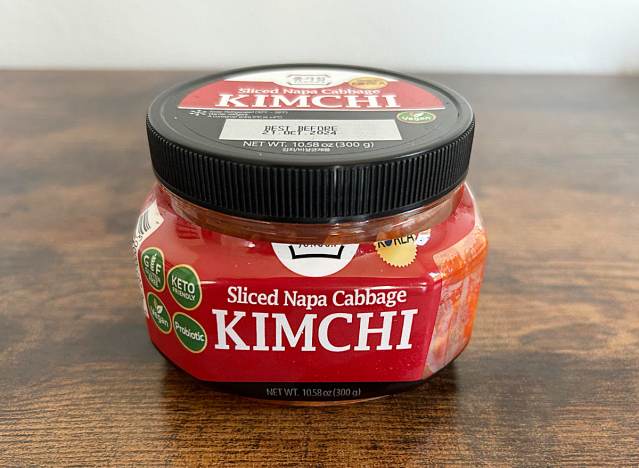
Calories: 10
Fat: 0 g (Saturated Fat: 0 g)
Sodium: 230 mg
Carbs: 2 g (Fiber: 1 g, Sugar: 0 g)
Protein: Less Than 1 g
Jongga is the top-selling kimchi brand in Korea and can be found in American supermarket chains like Costco, Walmart, H Mart, and 99 Ranch. I got the original mat kimchi for $4.99 at H Mart.
The look: Jongga is the brand I eat the most often because it’s available at Costco, so it’s the standard for me when I think of kimchi. It comes in a big jar with larger cuts of cabbage than the other brands.
The taste: The website claims “no added preservatives,” so since it’s an imported kimchi, the cabbage has more time to ferment and can be “bubblier” on the tongue, depending on the batch you get. Mine had clearly sat for a while, as it was not as crunchy or complex as Cleveland Kitchen and a bit soggy. The garlic is very strong, though well-balanced with the fish paste. I’m ranking it higher than Cleveland Kitchen because it’s more like kitchen kimchi versus a pickled hot dog topping.
Mama O’s Original Kimchi
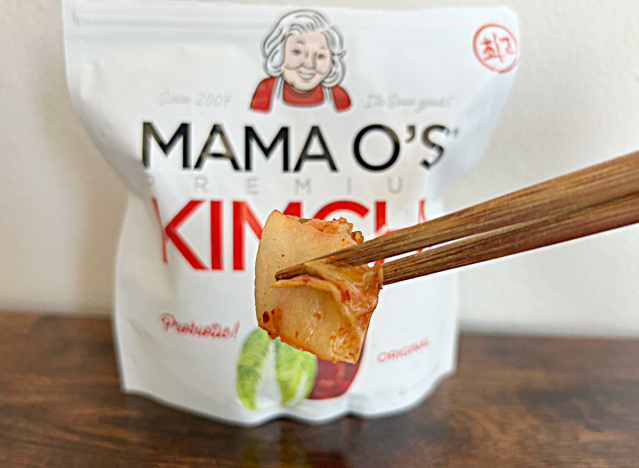
Calories: 10
Fat: 0 g (Saturated Fat: 0 g)
Sodium: 140 mg
Carbs: 2 g (Fiber: 0 g, Sugar: 1 g)
Protein: 0 g
Korean family-owned brand Mama O’s Original Kimchi is a classic napa cabbage kimchi that utilizes all-natural ingredients and traditional fish paste with anchovies. It retails for $9.99 at Central Market, though you can also find it at national chains like Whole Foods.
The look: Again, points off for the bag because it’s not as secure for long-term storage, but the kimchi itself looks bouncy and fresh.
The taste: This is a well-balanced kimchi with a satisfying thickness and bite, though it isn’t as crunchy as some of the other ones. I like the interplay between the sweetness of the cane sugar and the umami of the anchovies, and it isn’t too salty.
Tobagi
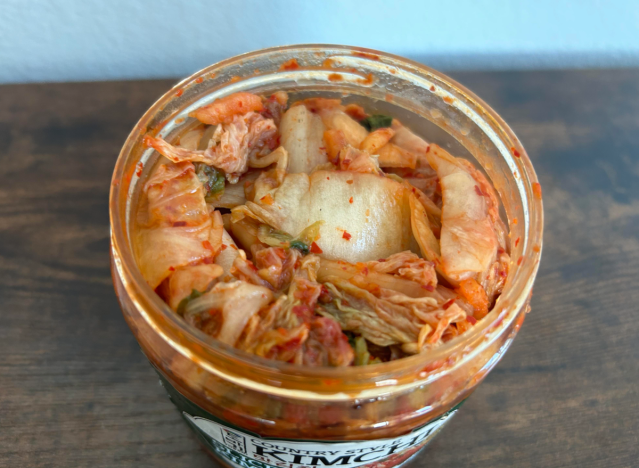
Calories: 25
Fat: 0 g (Saturated Fat: 0 g)
Sodium: 230 mg
Carbs: 4 g (Fiber: 2 g, Sugar: 2 g)
Protein: 1 g
Tobagi is a popular Korean brand available at H Mart that is widely considered a top supermarket kimchi choice in the Asian community. I got a 12-ounce jar of Tobagi Country Style Sliced Kimchi for $5.99 at my local H Mart, though prices may vary depending on location.
The look: Like everything in the kimchi section at H Mart, Tobagi either comes in gallon buckets or understated little jars. Non-Korean speakers should watch out for the small “Tobagi” label under the Korean symbols as it can be easy to miss. The kimchi itself looks better preserved than all the other ones, still retaining some color on the napa cabbage and a degree of separation rather than being a soggy clump.
The taste: Tobagi is the preferred store-bought kimchi brand of many fanatics—and I wholeheartedly concur. Not overly sour or cloyingly sweet, with a satisfying crunch and bite, Tobagi kimchi lightly fizzes on the tongue without tasting overly acidic. It uses apple and pear for sweetness as well as shrimp and anchovy paste, allowing the fish paste and garlic to really sing and bring out its sweetness without being gamey or rank.









